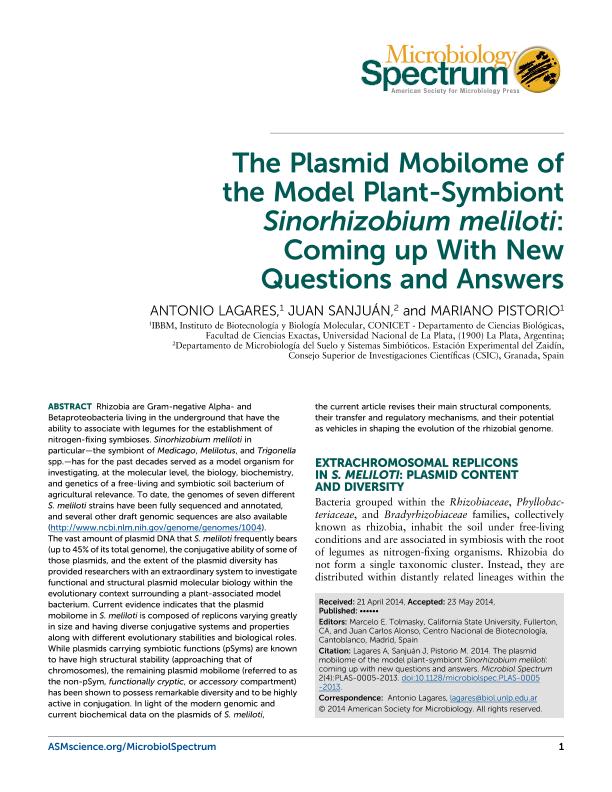Mostrar el registro sencillo del ítem
dc.contributor.author
Lagares, Antonio

dc.contributor.author
Sanjuán Pinilla, Juan

dc.contributor.author
Pistorio, Mariano

dc.date.available
2018-01-15T15:51:16Z
dc.date.issued
2014-07
dc.identifier.citation
Lagares, Antonio; Sanjuán Pinilla, Juan; Pistorio, Mariano; The Plasmid Mobilome of the Model Plant-Symbiont Sinorhizobium meliloti: Coming up with New Questions and Answers; American Society for Microbiology; Microbiology Spectrum; 2; 5; 7-2014; 1-5
dc.identifier.issn
2165-0497
dc.identifier.uri
http://hdl.handle.net/11336/33243
dc.description.abstract
Rhizobia are Gram-negative Alpha- andBetaproteobacteria living in the underground that have theability to associate with legumes for the establishment ofnitrogen-fixing symbioses.Sinorhizobium melilotiinparticular—the symbiont ofMedicago,Melilotus, andTrigonellaspp.—has for the past decades served as a model organism forinvestigating, at the molecular level, the biology, biochemistry,and genetics of a free-living and symbiotic soil bacterium ofagricultural relevance. To date, the genomes of seven differentS. melilotistrains have been fully sequenced and annotated,and several other draft genomic sequences are also available(http://www.ncbi.nlm.nih.gov/genome/genomes/1004).The vast amount of plasmid DNA thatS. melilotifrequently bears(up to 45% of its total genome), the conjugative ability of some ofthose plasmids, and the extent of the plasmid diversity hasprovided researchers with an extraordinary system to investigatefunctional and structural plasmid molecular biology within theevolutionary context surrounding a plant-associated modelbacterium. Current evidence indicates that the plasmidmobilome inS. melilotiis composed of replicons varying greatlyin size and having diverse conjugative systems and propertiesalong with different evolutionary stabilities and biological roles.While plasmids carrying symbiotic functions (pSyms) are knownto have high structural stability (approaching that ofchromosomes), the remaining plasmid mobilome (referred to asthe non-pSym,functionally cryptic,oraccessorycompartment)has been shown to possess remarkable diversity and to be highlyactive in conjugation. In light of the modern genomic andcurrent biochemical data on the plasmids ofS. meliloti,the current article revises their main structural components,their transfer and regulatory mechanisms, and their potentialas vehicles in shaping the evolution of the rhizobial genome.
dc.format
application/pdf
dc.language.iso
eng
dc.publisher
American Society for Microbiology
dc.rights
info:eu-repo/semantics/openAccess
dc.rights.uri
https://creativecommons.org/licenses/by-nc-sa/2.5/ar/
dc.subject
.
dc.subject.classification
Otras Ciencias Biológicas

dc.subject.classification
Ciencias Biológicas

dc.subject.classification
CIENCIAS NATURALES Y EXACTAS

dc.title
The Plasmid Mobilome of the Model Plant-Symbiont Sinorhizobium meliloti: Coming up with New Questions and Answers
dc.type
info:eu-repo/semantics/article
dc.type
info:ar-repo/semantics/artículo
dc.type
info:eu-repo/semantics/publishedVersion
dc.date.updated
2018-01-12T16:16:52Z
dc.journal.volume
2
dc.journal.number
5
dc.journal.pagination
1-5
dc.journal.pais
Estados Unidos

dc.journal.ciudad
Washington
dc.description.fil
Fil: Lagares, Antonio. Consejo Nacional de Investigaciones Científicas y Técnicas. Centro Científico Tecnológico Conicet - La Plata. Instituto de Biotecnología y Biología Molecular. Universidad Nacional de La Plata. Facultad de Ciencias Exactas. Instituto de Biotecnología y Biología Molecular; Argentina
dc.description.fil
Fil: Sanjuán Pinilla, Juan. Consejo Superior de Investigaciones Científicas. Estación Experimental del Zaidín; España
dc.description.fil
Fil: Pistorio, Mariano. Consejo Nacional de Investigaciones Científicas y Técnicas. Centro Científico Tecnológico Conicet - La Plata. Instituto de Biotecnología y Biología Molecular. Universidad Nacional de La Plata. Facultad de Ciencias Exactas. Instituto de Biotecnología y Biología Molecular; Argentina
dc.journal.title
Microbiology Spectrum
dc.relation.alternativeid
info:eu-repo/semantics/altIdentifier/url/http://www.asmscience.org/content/journal/microbiolspec/10.1128/microbiolspec.PLAS-0005-2013
dc.relation.alternativeid
info:eu-repo/semantics/altIdentifier/doi/http://dx.doi.org/10.1128/microbiolspec.PLAS-0005-2013
Archivos asociados
